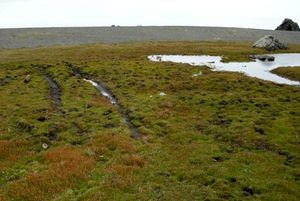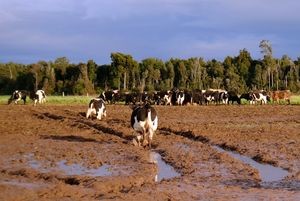 Coastal wetland damaged by vehicle tracks, Cape Palliser. Photo by John Sawyer.Habitat loss as a direct or indirect result of human activities is the major threat to indigenous plants both in New Zealand and globally (Dopson et al. 1999 and IUCN 2000). Habitat loss results in complete transformation of the environment at a site so that indigenous plants can no longer survive there. Human activities causing habitat loss include development (e.g., housing, industry, roads etc) and agriculture (e.g., wetland drainage or conversion to pasture or cropping).
Coastal wetland damaged by vehicle tracks, Cape Palliser. Photo by John Sawyer.Habitat loss as a direct or indirect result of human activities is the major threat to indigenous plants both in New Zealand and globally (Dopson et al. 1999 and IUCN 2000). Habitat loss results in complete transformation of the environment at a site so that indigenous plants can no longer survive there. Human activities causing habitat loss include development (e.g., housing, industry, roads etc) and agriculture (e.g., wetland drainage or conversion to pasture or cropping).
 Intensive agricultural activities contribute to habitat loss. Photo: Jesse BythellHabitat loss can reduce plant population sizes, erode genetic diversity and can ultimately lead to species extinction. There are many inevitable consequences of habitat loss including fragmentation, where smaller parts or remnants of native habitats are isolated from each other and invasion by exotic animal pests and weeds. Habitat loss can also interrupt plant dispersal and detrimentally affect soil fertility and impact on ecological systems such as pollination.
Intensive agricultural activities contribute to habitat loss. Photo: Jesse BythellHabitat loss can reduce plant population sizes, erode genetic diversity and can ultimately lead to species extinction. There are many inevitable consequences of habitat loss including fragmentation, where smaller parts or remnants of native habitats are isolated from each other and invasion by exotic animal pests and weeds. Habitat loss can also interrupt plant dispersal and detrimentally affect soil fertility and impact on ecological systems such as pollination.
Not all plants are equally affected by habitat loss but an increasing human population continues to pose the most serious threat to plant biodiversity.
For more information about habitat loss see:
- IUCN Red List of Threatened Species - 2000 - Compiled by Craig Hilton-Taylor. Gland (Switzerland): IUCN Species Survival Commission. 61 p.
- The conservation requirements of New Zealand’s nationally threatened vascular plants, 1999, by Suzan Dopson, P.J. de Lange, C.C. Ogle; B.D. Rance; S.P. Courtney; J. Molloy. Threatened Species Occasional Publication no.13, Department of Conservation.
